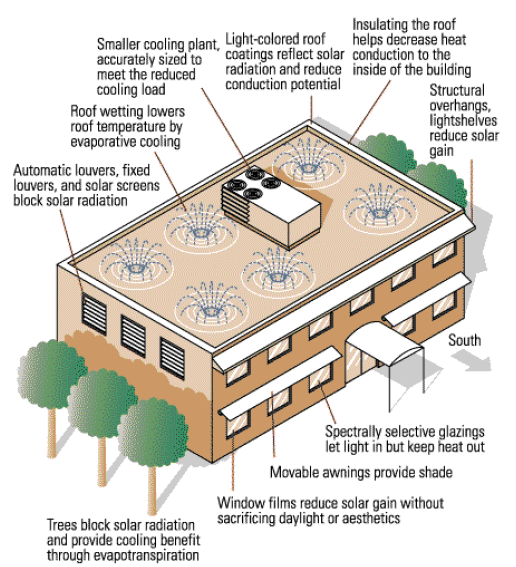HVAC: Centrifugal Chillers
Does your building have a centrifugal chiller? If it does, you should know that chillers typically consume more electricity than any other single energy-consuming device in a commercial building, except for an occasional extremely large fan.
Inefficient chillers can waste significant amounts of electricity, and even modest improvements in efficiency may yield substantial energy savings and attractive paybacks.
However, it's important to select a chiller (and its associated efficiency) carefully-buying a chiller that is highly efficient may not be cost-effective in all cases. It is also important to remember that chillers are actually part of a chilled water system, and the efficiency and control of pumps and cooling towers can have a significant impact on overall efficiency.
Maximizing the efficiency of the chiller alone does not ensure that the system will operate efficiently. To maximize cost-effectiveness, we recommend analyzing the entire chilled water system as well as exercising care in specifying the efficiency of the chiller itself.
What Are the Options?
Centrifugal chillers, which are the workhorses of the comfort cooling industry, have very few moving parts (Figure 1). Therefore, they usually offer high reliability and low maintenance requirements.
A centrifugal compressor acts very much like a centrifugal fan, compressing the vapor flowing through it by spinning it from the center of an impeller wheel radially outward, allowing centrifugal forces to compress the vapor. Some machines use multiple impellers to compress the refrigerant in stages.
Figure 1: Centrifugal chiller cutaway
Source: York International
Centrifugal chillers are available in sizes ranging from 70 to 2,500 tons factory-assembled and up to 9,000 tons field-assembled. They use HCFC-123, HFC-134a, or HCFC-22 refrigerants.
Chillers that use HCFC-123 currently have the highest efficiencies, down to 0.49 kilowatts per ton (kW/ton) at full load and ARI conditions (see box, Chiller Terminology). Although full-load efficiency is often cited in sales literature and energy codes, it is usually not the most important metric of efficiency in practice. Because most chillers rarely operate under full-load conditions-less than 2 percent of annual run hours in most cases-it is usually more important to consider chiller efficiency at "off design" conditions when the chiller delivers only a fraction of its full cooling capacity.
Although HCFC-123 machines cannot achieve very low temperatures, this does not limit their use in most space cooling applications. The best HFC-134a chiller available provides an efficiency of 0.55 kW/ton at full load and ARI conditions. Although HCFC-22 chillers are typically less efficient, they are occasionally selected because they may be smaller in size than chillers of comparable capacity charged with other refrigerants.
Figure 2: Components of a typical chilled water system
Source: Platts
Components of a Chilled Water System
In a typical large commercial building (Figure 2), a central chiller plant, consisting of one or more chillers and their ancillary systems, provides chilled water for air conditioning. This chilled water is pumped to one or more air handlers throughout the building, where it absorbs heat from warm indoor air. The cool air is then distributed around the building through a network of ducts.
The chilled water plant also requires several additional components (often called auxiliary or ancillary systems) to move chilled water between the chilled water plant and the air handlers and reject heat from the chiller to the outside world. Auxiliary devices include chilled water pumps, condenser water pumps, and cooling towers.
How to Make the Best Choice
The bottom line. You can install the highest-efficiency chiller available in your building, but if it is part of an inefficient system, you won't be capturing all the benefits of the chiller. You need to optimize the entire chiller system to reap the best savings. (See box, Components of a Chilled Water System.)
BEFORE SELECTING A CHILLER
Reduce cooling loads. About half of the cooling load in an inefficient building comes from solar gain and lighting, so careful treatment of these two sources of heat gain can yield impressive savings. A lighting retrofit offers direct energy savings in addition to reducing the cooling load for the building. Figure 3 illustrates several ways to reduce solar heat gain. Figure 3: Building-shell cooling load reduction measures.
This representative commercial building (figure below) displays a variety of techniques for reducing cooling loads, including roof-wetting to lower temperatures through evaporative cooling.
Optimize HVAC auxiliary systems. Cooling tower fans, condenser and chilled water pumps, and air and water distribution systems should all be analyzed for potential efficiency improvements. Optimize control of the system and its components.
In many cases, significant energy savings can be achieved by modifying the operating characteristics of chiller plant components during part load conditions. Microprocessor-based building automation systems can be programmed to adjust operating parameters in near-real time to maximize overall chiller plant efficiency.
Source: Platts
Chiller Terminology
Tons: One ton of cooling is the amount of heat absorbed by one ton of ice melting in one day, which is equivalent to 12,000 Btu/h or 3.516 thermal kW.
kW/ton rating: Commonly referred to as efficiency, but actually power input to compressor motor divided by tons of cooling produced, or kilowatts per ton (kW/ton). Lower kW/ton indicates higher efficiency.
Coefficient of performance (COP): Chiller efficiency measured in Btu output (cooling) divided by Btu input (electric power). Multiplying the COP by 3.412 yields the energy-efficiency ratio.
Energy-efficiency ratio (EER): Performance of smaller chillers and rooftop units is frequently measured in EER rather than kW/ton. EER is calculated by dividing a chiller's cooling capacity (in Btu/h) by its power input (in watts) at full-load conditions. The higher the EER, the more efficient the unit.
ARI conditions: Standard reference conditions at which chiller performance is measured, as defined by the Air-Conditioning and Refrigeration Institute (ARI): 44oFF for water leaving the chiller and, for water entering the condenser, 85oF at 100 percent load and 60oF at zero percent load.
Integrated part-load value (IPLV): This metric attempts to capture a more representative "average" chiller efficiency over a representative operating range. It is the efficiency of the chiller, measured in kW/ton, averaged over four operating points, according to a standard formula.
WHEN DECIDING WHICH CHILLER TO BUY
Compare chillers at a variety of efficiency levels to determine the best buy. Annual energy costs for a chiller may amount to as much as a third of the purchase price, so even a modest improvement in efficiency can yield substantial energy savings and attractive paybacks.
For example, paying an extra $6 per ton for each 0.01 kW/ton improvement to raise the efficiency of a 500-ton chiller from 0.6 kW/ton to 0.56 kW/ton would increase that machine's first cost by $12,000. But that change might reduce operating costs by as much as $3,000 per year-assuming 1,500 equivalent full-load hours and electricity at an average price of 10¢ per kilowatt-hour (kWh), including demand charges-yielding a four-year simple payback.
For a chiller that operates fewer hours and would therefore produce lower savings, some buyers might choose to forgo both the efficiency improvement and the additional cost. Most manufacturers have software that will help you make such evaluations.
Compare chillers under the conditions they are most likely to experience. Even though chiller performance can vary dramatically depending on loading and other conditions, designers frequently select chillers based on full-load, standard-condition efficiency. But chillers run for most hours at 40 to 70 percent load, under conditions that often vary considerably from standard conditions.
To select the chiller that will have the lowest operating costs, evaluate the efficiency of various candidate chillers under the actual operating conditions the equipment is likely to experience.
Account for system effects when comparing chillers. Although it is tempting to improve the efficiency of chilled water systems by minimizing the energy consumption of each individual component, that approach does not necessarily lead to the most efficient system.
The pieces of a chilled water system interact in complex ways that make such general prescriptions difficult. For example, although the efficiency of a chiller can be improved by increasing chilled water flow, that will require more pumping power, which may exceed the saved chiller power and result in a net loss in system efficiency.
Consider using computer simulations to model building cooling loads throughout the year. Computer simulation programs are available that can carry out the numerous and complex equations needed to evaluate how buildings use energy under different conditions.
The most sophisticated programs are capable of calculating building energy consumption hour by hour for an entire year; they can also account for interactions between building components. This allows you to experiment with different combinations of efficiency strategies to determine which ones will be most cost-effective.
The best-known hourly simulation software is DOE-2 (developed by the Simulation Research Group at Lawrence Berkeley National Laboratory), but there are several other packages available on the market, a few of which are produced by HVAC equipment manufacturers.
It takes some practice to become adept at using these building energy performance simulations-you may prefer to hire consultants who specialize in performing these evaluations.
Select unequally sized machines for multiple chiller installations. Constant speed chillers operate most efficiently when they are loaded close to their full rating (about 75 percent for most chillers). If one chiller in a two-machine installation is smaller than the other, under most operating conditions, one of the two chillers should be able to handle the job running close to full load.
Having the option of switching between plants with different capacities will result in more efficient operation than if one or two same-sized chillers were operating at a lighter load. Consider a chiller with a variable frequency drive (VFD) to maximize part load efficiency and energy savings.
Variable speed centrifugal chillers are now offered by all of the major manufacturers and offer energy performance that is superior to traditional constant speed chillers under most conditions-particularly part load operation. Chillers equipped with VFDs typically have IPLV values between 0.35 and 0.45 kW/ton, which is considerably better than their constant speed brethren. Some manufacturers are fairly new to the VFD chiller market, however, so it pays to research the track record of specific products before you make a purchase.
What's on the Horizon?
The classic vapor-compression cycle has provided cooling for large air-conditioning applications for nearly a century, but in the future, other, higher-efficiency cooling methods may come to the fore. One interesting system now under development takes advantage of the magnetocaloric effect-the property of some metals to heat up when they are magnetized and to cool down when they are demagnetized. The prototypes are using cylinders of the rare-earth metal gadolinium, along with a superconducting magnet. Magnetocaloric chillers have the potential to be highly efficient, but currently they are much more expensive than vaporcompression chillers. Research is underway to reduce the cost of chillers based on this novel technology.
Trane is starting to offer oil-less compressors as an option on their centrifugal chillers. The compressor uses ceramic bearings that obviate the need for lubrication oil to be mixed with the refrigerant. The benefit is that the chiller can operate reliably at very low load conditions where chillers that require oil may falter.
HVAC: Centrifugal Chillers
There are four major manufacturers of centrifugal chillers:
The Trane Company manufactures both HCFC-123 and HCFC-22 chillers with multi-stage compressors.
Carrier Corporation manufactures HFC-134a and HCFC-22 chillers.
York International manufactures HFC-134a, HCFC-123, and HCFC-22 chillers.
McQuay manufactures HFC-134a chillers.




